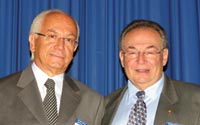Genomics pioneer says ophthalmology ‘leading charge’ in applying research
New techniques, long-term follow-up and research highlighted the main lectures at this year’s AAO.
Click Here to Manage Email Alerts
![OSN at AAO meeting [logo]](/~/media/images/shared-images/aao_200_85_6257.gif) CHICAGO – The study of genomics has reached a level in ophthalmology that is still only a distant hope for other medical specialties, said an expert in genomics speaking here.
CHICAGO – The study of genomics has reached a level in ophthalmology that is still only a distant hope for other medical specialties, said an expert in genomics speaking here.
“Your field of ophthalmology is on the cutting edge of my topic, which is to emphasize how our understanding of the genome is beginning to impact the practice of medicine in dramatic ways,” said Francis S. Collins, MD. “Ophthalmology is leading that charge.”
Dr. Collins, the director of the National Institute of Health’s National Human Genome Research Institute, delivered the keynote speech at the opening session of the American Academy of Ophthalmology meeting.
He described an effort, known as the International HapMap Project, which aims to identify and catalog genetic similarities and differences and place all data in a public database. The six-country project, which has been under way for 3 years, will be completing its work within the next 2 weeks, he said.
This project’s first success story involved age-related macular degeneration, according to Dr. Collins.
Bimanual MICS advances cataract surgery
The impact of bimanual microincision cataract surgery can be equated with that of phacoemulsification, according to the first presenter of a new named lecture.
Bimanual microincision cataract surgery (MICS) is a development that “alters cataract surgery as physicians currently know it,” said I. Howard Fine, MD. Dr. Fine delivered the inaugural Charles D. Kelman Lecture at the AAO meeting.
Hyperopic LASIK stable with long follow-up
|
|
With follow-up of 5 to 8 years, LASIK correction of hyperopia and hyperopic astigmatism was accurate and stable, according to this year’s Barraquer Lecturer.
Carmen Barraquer, MD, focused on the challenges of hyperopia correction facing refractive surgeons as she delivered the lecture named for her father, José Barraquer.
Dr. Barraquer discussed the results of a retrospective study, with follow-up of 5 to 8 years, of hyperopia and hyperopia with astigmatism in young patients. The study included 74 eyes of 41 patients who ranged in age from 8 to 26 years, she said.
In the low hyperopia group, 90% were within 0.5 D of emmetropia after surgery. In the moderate group, 82% were within 0.5 D of emmetropia, and in the high hyperopia group, 30% were within 0.5 D of emmetropia. All patients were within 1 D of emmetropia, Dr. Barraquer said.
Almost all eyes in the moderate hyperopia group (97%) had unchanged uncorrected visual acuity postoperatively, while 95% of the low hyperopia group and 88% of the high hyperopia group had unchanged UCVA. Best corrected visual acuity remained unchanged in 95% of the low group, 94% of the moderate group and 65% of the high hyperopia group, he said.
Drug treatments for diabetic edema show promise
Several medical therapeutic strategies for diabetic macular edema (DME) have shown promising early results in studies, said Alan Ruby, MD.
He reviewed the results of studies of periocular, intravitreal and sustained-release drug delivery for DME.
Sub-Tenon’s injection of steroids is a low risk therapy for DME, Dr. Ruby said. In a study of 21 patients with diffuse DME, the mean visual acuity improved from 20/75 to 20/50, he said. At the 9-month follow-up point, none of the patients required reinjection.
Sub-Tenon’s Kenalog (triamcinolone acetate, Bristol-Myers Squibb) “does appear to be efficacious in reducing macular edema as assessed by optical coherence tomography,” he said.
When injected intravitreally, Kenalog remains in the vitreous cavity for 3 to 6 months, and results are often achieved in 1 week, Dr. Ruby said. Intravitreal administration provides therapeutic levels of the drug rapidly, he said, but complications, while rare, can be serious.
Dr. Ruby also discussed two implants that provide sustained release of steroids.
Retisert (fluocinolone acetonide, Bausch & Lomb) may require patients to use IOP-lowering drugs and can cause cataracts, he said. The device, recently FDA approved, has a high cost and a high rate of complications, he said.
Posurdex (dexamethasone, Oculex/Allergan) is a long-term implant, an extended-release pellet made of a biodegradable polymer called PLGA. It is easy to insert in the office, and improvement of visual acuity was seen in 36% of patients in a recent study, he said.
For all of these therapies, Dr. Ruby said, further studies are warranted.
|
|
Perceptual training can sharpen contrast sensitivity
A vision-training regimen based on visual stimulation and repetition may help sharpen contrast sensitivity and visual acuity in low myopes and patients with residual refractive error after refractive surgery, said Donald T.H. Tan, FRCS.
Prof. Tan described his experience with the NeuroVision NVC vision correction technology during Refractive Subspecialty Day. The technology is a noninvasive, patient-specific treatment based on visual stimulation and facilitation of the neural connections responsible for vision, Prof. Tan said. The system uses an Internet-based, computer-generated visual training exercise regimen of patient-specific stimuli to sharpen contrast sensitivity and visual acuity, he said.
Dilation agents may induce unnatural pupil centroid shift
Use of a dilating agent before refractive surgery may cause problems with wavefront measurements, according to one surgeon.
“Pharmacologics may well interfere with the custom treatment process and shift the pupil centroid from a naturally dilated pupil,” said K. Ashley Tuan, MD, speaking at Refractive Sub-specialty Day.
Dr. Tuan examined 32 eyes to determine the effect of medical dilation on wavefront measurement and pupil centroid. Baseline measurements were first performed on the patient’s dark-adapted pupil. Then one drop of 0.05% tropicamide was administered, and wavefront measurements were taken after 10, 20 and 30 minutes.
The average dark-adapted pupil was 6.4 mm in diameter. After administration of the tropicamide, the pupil centroid was found to have shifted with no discernable pattern, Dr. Tuan said.
LASIK still most common refractive surgical procedure
An annual survey indicates that LASIK is performed by about 90% of refractive surgeons, said Richard J. Duffey, MD, during Refractive Surgery Subspecialty Day.
After LASIK, the most common refractive surgical procedure is PRK, performed by 68% of respondents, followed by limbal relaxing incisions/IOL (57%), refractive lens exchange (39%) and limbal relaxing incisions alone (26%). Other refractive procedures were performed by less than 25% of respondents to the survey.
Corneal inlay shows promise for presbyopia in early trials
An intracorneal inlay is a “promising method” of improving near vision, said one surgeon speaking here.
Daniel S. Durrie, MD, spoke about the Acufocus Intracorneal Inlay during the Refractive Surgery Subspecialty Day. The first human implants of the device were in 2001, and an updated product design was completed earlier this year, Dr. Durrie said.
The Acufocus is an ultrathin device, about 10 µm in thickness, he said. It features an opaque biocompatible polymer with optimized small-aperture optics.
Crosslinking with single-segment Intacs improves outcomes in ectasia
|
|
Crosslinking of corneal collagen fibers, used in conjunction with implantation of an intrastromal corneal ring segment, can improve outcomes in ectasia or keratoconus after LASIK, according to a surgeon speaking here.
Munish Sharma, MD, MBBS, told attendees during a free paperssession that corneal collagen crosslinking with riboflavin, dubbed C3-R, increases the number of corneal collagen molecules. Used in conjunction with one Intacs ring segment (Addition Technology) to treat ectasia and keratoconus after LASIK, the riboflavin significantly improves the lower-upper corneal curvature ratio, he said.
The lower-upper ratio is the relationship between the sums of five upper and lower keratometry values, Dr. Sharma said.
In a study of 56 eyes treated with and without C3-R following implantation of single-segment Intacs, the mean postop lower-upper ratio and the difference from preop to postop lower-upper ratio significantly improved in the C3-R/Intacs group compared with the Intacs-alone group.
“Intacs causes a mechanical flattening, and C3-R augmented the reversal effect of Intacs,” Dr. Sharma said.
Vision loss in cancer patients deserves special consideration
General ophthalmologists and neuro-ophthalmologists alike must be aware that a history of cancer is an important factor in diagnosing vision loss in their patients, said Nicholas J. Volpe, MD. In patients with such a history, complications of cancer must be considered in the differential diagnosis to ensure proper management, he said.
Speaking during the Neuro-ophthalmology Subspecialty Day, Dr. Volpe said that the direct effects of cancer can affect the visual pathway at many points, and the remote effects through paraneoplastic processes can also alter both retinal and optic nerve function.
Glaucoma implant shows IOP-lowering effect similar to trabeculectomy
A miniature glaucoma shunt implanted under a scleral flap is equally successful in lowering IOP as trabeculectomy but has a lower hypotony risk, according to a poster presentation.
Peter J.G. Maris, MD, and Peter Andreas Netland, MD, PhD, performed a comparative case-control series of 100 eyes, half of which were treated with the ExPress miniature glaucoma shunt from Optonol and the other half with trabeculectomy.
IOP dropped 53.7% in eyes in which the ExPress shunt was implanted under a scleral flap, compared with 53.6% in eyes that underwent trabeculectomy. Hypotony occurred in 6% of the eyes with the implant, compared with 34% of the eyes with trabeculectomy.
“The ExPress implant under a scleral flap had similar IOP-lowering efficacy, with a lower rate of hypotony, compared with trabeculectomy,” the study authors concluded.
Endothelial cell loss with phakic IOL highest in first postop year
Phakic IOLs are associated with an elevated rate of endothelial cell loss in the first year after implantation, but the cell loss returns to normal in subsequent years, said Helen K. Wu, MD. She warned surgeons, however, that “ongoing monitoring of endothelial cell loss is imperative” in patients with phakic IOLs.
Dr. Wu, spoke at Refractive Surgery Subspecialty Day about endothelial cell loss after implantation of both anterior and posterior chamber phakic IOLs.
After phacoemulsification, Dr. Wu said, “generally speaking, there is a 10% cell loss.”
Glaucoma risk tool identifies patients needing treatment
A handheld calculator designed to predict the risk of glaucoma progression in patients with ocular hypertension could change the standard of care for glaucoma specialists, according to one of its developers.
Robert N. Weinreb, MD, described the risk calculator at a press briefing sponsored by Pfizer Ophthalmics during the American Academy of Ophthalmology’s annual meeting.
“This is what we’ve all been waiting for – the ability to calculate the risk (of glaucoma progression) in individual patients,” Dr. Weinreb said.
Systemic AMD treatment shows promise, must be studied prospectively
A systemic treatment for neovascular age-related macular degeneration is showing promising results, said Philip J. Rosenfeld, MD, PhD. He presented a summary of recent findings with the VEGF-blocking agent bevacizumab during Retina Subspecialty Day.
The drug, which is approved for use in colorectal cancer, is attractively priced for this off-label ophthalmic application, but its safety profile in the eye is unknown, Dr. Rosenfeld said.
“Avastin (bevacizumab, Genentech) isn’t going to go away. The retrospective results are too promising and the pricing is too attractive,” Dr. Rosenfeld said. “It needs to be studied prospectively, and it needs to be compared to Lucentis.”
Lucentis (ranibizumab) is being studied in clinical trials by Genentech for the treatment of wet AMD.



